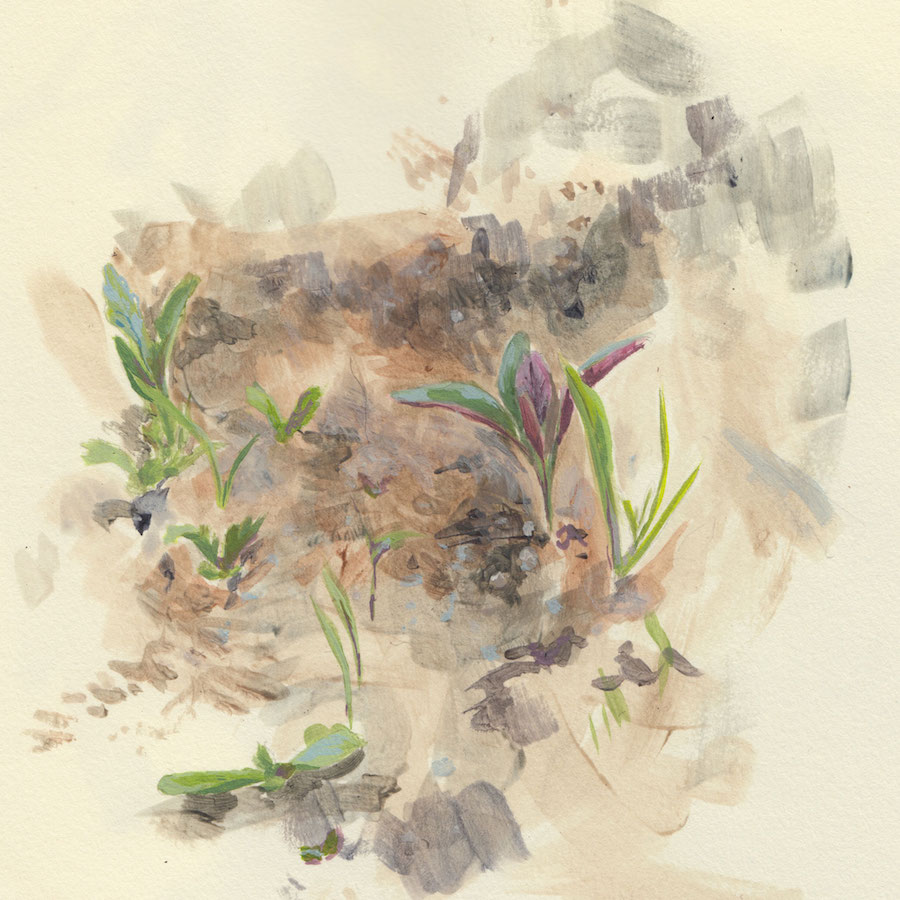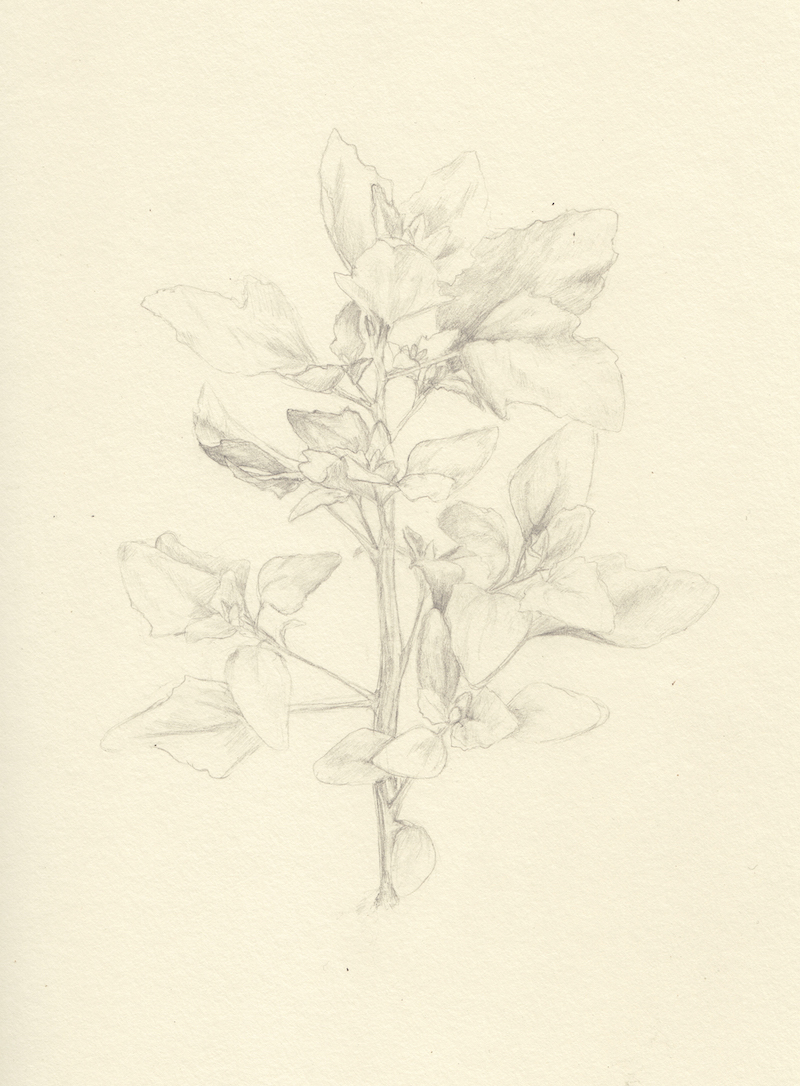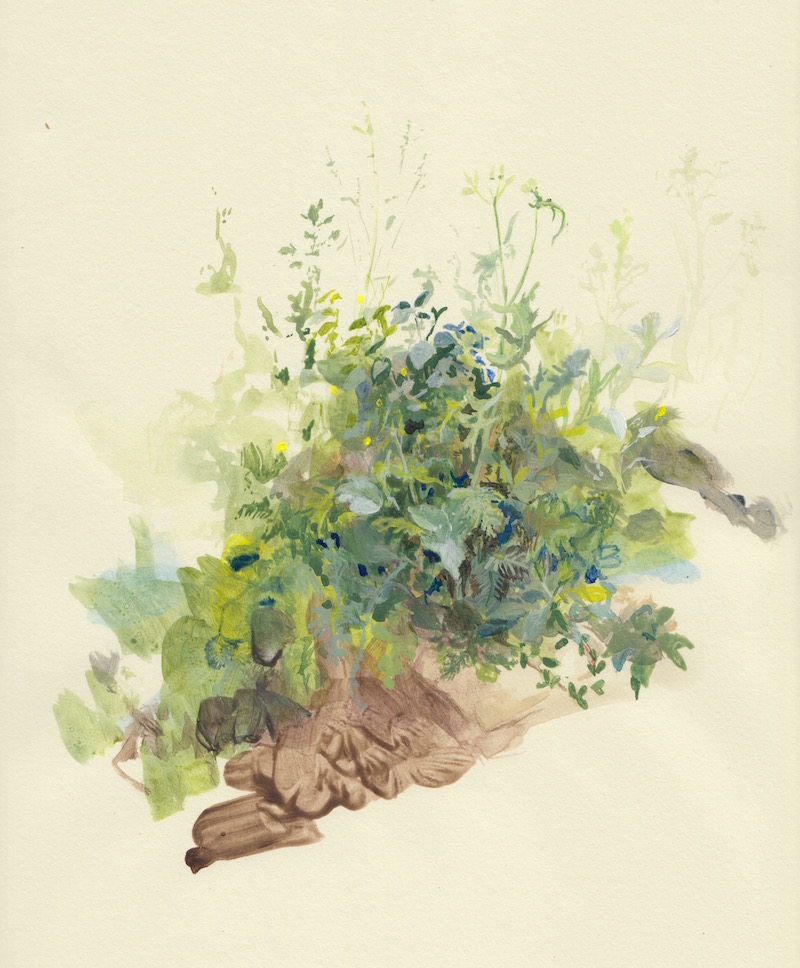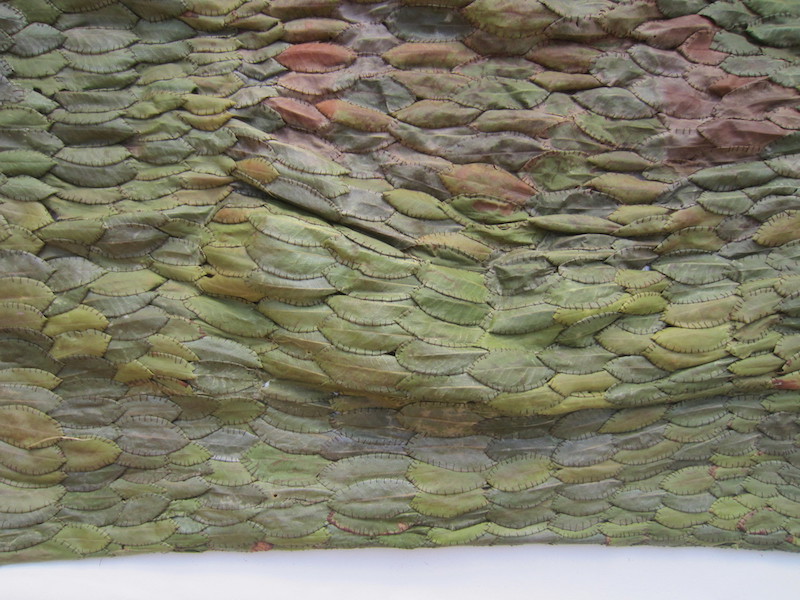Sharon Arnold
illustrations by Markel Uriu
For those of us identified as white, the idea that we’ve lost culture, or cultural belonging and meaning, is easy to believe. It’s because of this that we so often take from others; co-opting cultural practices, aesthetics, and even stories. We see this in every corner of society from spirituality, health, and wellness to beauty, fashion, literature, and art.
But we all have our own stories and histories that shape us. It is by design that those lineages are altered and obfuscated, to hold up the foundation and the armature of white supremacy—whiteness is the forfeit of ethnicity. This is a precarious situation, because if left unchecked, our misplaced attempts to associate with any form of culture can lead to cherry picking, even from our own traditions. This selective misappropriation is dangerous precisely because of the ambiguity of information out of context to its origins. At its worst, this cherry picking leads to false notions of ethnic purity, a harmful myth designed by white supremacists to uphold whiteness and gatekeeping through false ideologies of “blood lineage”. Blood and DNA are not culture. Culture is defined by a sovereign self-determination of identity and community, and expressions that describe it such as art, music, folklore, language, and storytelling. Therefore we must remember, in our own attempts to reshape ourselves in reconnection to culture and cultural histories, to not perpetuate the methods of exclusion, violence, and colonization in our practices.

This is a venture into learning our own stories as a point of departure to decolonize ourselves1 and unsettle settler colonialism2, and dismantle whiteness and white supremacy. Regardless of our spiritual inclinations, it’s the search for the origin and origin story, and cosmology that interests me. The root of our movement through the world begins with us, and our understanding of who we are and where we come from. Essentially, this is a foundation of ancestor work. Ancestor work is spiritual, but it is also practical. In ensuring we don’t spiritually bypass the hard work of acknowledging, recognizing, and naming our ancestors and our cultural pasts, good and bad, we begin to unravel that work outward in all directions3. As someone coming to this work through the arts, I strongly feel those of us working with a vast lexicon of semiotics, symbology, and iconography have all the more responsibility to consider how this work may have a positive impact and tremendous benefit to all areas of our lives.
What follows are excerpts from the intro of an upcoming, as yet untitled, project inspired by European ritualistic uses of plants with smoke and water. The project itself will cover some speculation on why I think smoke and water are so meaningful throughout the world; my perspective on animism as a practice of acknowledging the life and spirit in all beings and places, and how that shifts our relationships to be more reciprocal; a series of about 20 plant monographs focused on each plant’s use in smoke and/or water methods; and a little bit about how traditional plant uses can translate to where we are living, today. My interest in this came about over time—the desire to connect to my own ancestral language and cultures began in early childhood; and my connection to herbal uses, histories, and lore began in the early days of my former life as a professional chef. But around 10 years ago I started digging into research to find and build a vocabulary of appropriate language with which to describe the ways a spiritual practice can also be a pushback to both assimilation and cultural theft, to relearn the missing parts of ourselves.
So while this writing is about plants, what it really attempts to describe is the work of beginning a practice of cultural reconnection. It is my express belief that re-rooting ourselves in a better understanding of our own traditional cultures increases our literacy, respect, and understanding of—and solidarity with—a multitude of others. For these reasons, the focus of my own research has been Eurocentric, informed by mostly Irish, Scottish, and English resources4, but I want to also note that in using the term “European” I am not coding Europeans as white. Europe has always been multi-racial and multi-ethnic, and European-rooted traditions are practiced by and available to everyone. It’s my hope this guide is inspiring, helpful, and useful to people from any and all places, cultures, and traditions. So many of us from around the world are seeking to reconnect to meaningful cultural practices in the wake of colonialism, and that is good and important work.
Researching this over time has been inspiring, and my hope is that this information does the same for you. Maybe it also sparks some excitement or relief in knowing that yes, these practices do have a longstanding history across all lineages, and we don't need to start from scratch, steal, or reinvent anything. This guide is written for people interested in the cultural roots and reasoning for why certain plants are used, why their various symbolisms mean what they do, and for people looking to tether a spiritual connection to these practices. Knowing that my own access to historical information is limited as an independent researcher, I want to be transparent in the way this guide will evolve over time, as a “living document”, revised in subsequent editions to accommodate new information or resources I find (which will all be included in the project). I think this kind of transparency is important, because learning is an evolution, never an arrival.
Intro
For transparency, I’d like to begin with stating who I am not. I am not an academic. I’m not a lettered historian, anthropologist, or folklorist. Nor am I a professional herbalist or spiritual practitioner. Who I am is a writer and sometimes educator who weaves social philosophy and cultural theory into a personal practice of folk traditions, with a strong desire to dismantle systems of oppression within myself and in the world. Reconnecting to ancestors and traditions is a huge part of that path. I believe that sharing what I learn about this work in my community helps further deeper discussions and action in regards to reclaiming identity, and living in reciprocity and right relationship5 to each other, ancestors, spirits, and the land.

Many historians, anthropologists, folklorists, herbalists, and spiritual practitioners have written extensively on the histories and practices of spiritual cleansing, purification, protection, and blessing. Therefore, this is not an instruction manual. Consider this the beginning of a conversation with some historic and folkloric highlights to point you in a few directions. My purpose is not to reinvent the wheel, but to help turn it.
If you are reading this, you’re probably aware of the way mainstream conversation around the spiritual use of plants, particularly in the United States, has shifted to ask how we avoid wrongfully taking and profiting from the language and practices of North, Central, and South American Indigenous6 peoples. Additionally, the large-scale commercialism of white sage, desert sage, tobacco, and sweetgrass; as well as copal and palo santo, has lead to capitalist-driven extraction industries built upon the perceived marketability of these plants and traditions7. More and more, white folks are coming together to collectively learn, and discuss, how the way to end this cycle is to turn our attention towards our own lineages of cultures and practices, rather than the cultures and practices of others.
The predominant question is so often, if not these cultures, languages, and plants, then what?
In response, I’ve been sorting out how these questions become more specific to ask, what are the practices of our own ancestors; what are their languages, and plant rituals? and, why do certain plants and practices carry the symbolism they do? How does this symbolism tell me how, when, and where to use them?
And lastly, how do we appropriately and respectfully honor our own ancestral traditions, and any other European traditions we’re drawn to?
A good place to start is researching and learning more about the cultures of our own forebears. Most of us will learn, or already know, that our ancestry is a rich mixture of ethnicities and cultures. This is especially true for those of us working in American folk practices that naturally syncretize8 multiple traditions together. For those of us without access to our familial histories, this is where we can find our reassurance—no matter who our ancestors were, we most certainly come from a broad array of cultures and places. This can be exciting, but also overwhelming—how do we choose? What is right? This is a much larger conversation, but I would say it begins with finding what remnants of cultural traditions remain in your family life, tracing family names and genealogy, and doing some foundational ancestor work. If you’ve been severed from your family lineage, or if you’re new to these practices; take the time to observe what you feel most drawn to in regards to European traditions, and why you feel drawn to certain cultures and places, and go from there. Chances are, you will find or be attracted to several and your practice will reflect that!
It’s important to acknowledge how hard it is to rebuild these pieces of knowledge for ourselves. There are some real and valid obstacles to finding information about these cultural histories, and this is where a lot of us get stuck. This search is an inherently complicated and challenging task, because those of us disconnected from culture must learn about ourselves and/or our interests through books and online archives. Depending on how deep we go, it could mean sorting through multiple academic materials from genealogy, science, history, and anthropology to art history, culinary history, philosophy, religion, and spirituality. No matter what level your research, just know that some degree of this work is going to be a critical foundation for most things you do. I promise, you don’t need to be an academic, nor do you need to become a rigorous historian. This is really just about finding a healthy balance between the experiences you have, and cross-referencing them with some basis in a tangible history.

There are very few unbroken lines from the far past to the present. Multiple points of cross-cultural merging and syncretism have occurred and affected our traditions along the way. The more diasporic our communities, the less a connection we have to the original cultures from which we hope to learn and benefit. Beyond that, capitalist-colonial-driven new age spiritualism and neopaganism, historical works of either colonial or speculative anthropology, and various books in fantasy fiction9, have done a great deal of damage. This damage occurs because of the ways these authors have stolen and nebulously held, if not overwritten and redefined, many legitimate practices from all cultures. Even folklore has at times been documented with a colonial lens and requires examination. These obstacles can make tracing various pieces of information to their origins even harder. Instead, we have to hold the complexity that learning what pieces we can find of historical information may be incomplete; and that we must examine them through various lenses including the ways our contemporary needs are both the same, and different. In doing this work and research, we’re not attempting to preserve ancient ways in amber, nor are we attempting to create a roleplaying fantasy world, but instead take what we learn and apply that knowledge in ways that have meaning to our 21st century lives.
Ultimately, this practice is a commitment to the long and difficult process of finding the foundations we need to root ourselves authentically. It's also about how to ground ourselves respectfully in accordance with our personal philosophies, beliefs, and practices. And it’s about tying these practices directly to our work in actively dismantling white supremacist and capitalist systems. It’s my hope that this guide is of interest to you because this is the work you want to do, or that you are already doing.
Philosophies And Reasoning
This is an invitation to learn about some traditions you have access to in ways that maybe even inspire your own ongoing research. I wrote this in the interest of nurturing a reconnection to, and relationship with, some cultural roots around these specific uses of herbs, smoke, woods, and water. This is a philosophical pursuit that I hope draws a throughline from some history to contemporary life, with some usefulness and maybe even some poetry.
I’m also hoping to describe some of the symbolism of plants in ways that feel concretely connected to them. Many, if not all of these plants have their associations rooted in the very folklore from the lands they come from, supporting our purposes for using them as people threading layers of meaning. History and folklore can sometimes offer us this meaning, as well as information, as passed down to us in the form of storytelling. Because I strongly believe language and folklore are two of the many ways in which intergenerational knowledge is passed down, this transmission of information is the most incredible gift, if we’re able and willing to accept it! And towards the end of gifts well received; and inspiration and creativity, these roots become a critically important foundation for each of us. We can take what we know of plants and their cultural lore as a ground to create something new from them, adding to the richness of the practices and traditions in which we are working.
Consider the information in this guide as suggestions in spirit, rather than some letter of law. In contemporary colonial environments, we have a dilemma. We feel both culturally lost, but also averse to adhering or being asked to adhere to cultural protocols and safeguarding10. We have a hard time accepting that, sometimes, rules and structures are in place for a reason. Among those reasons are preservation, sovereignty, and self-determination of tradition as held by the people who live within culture, in right relationship to its history and to each other. Bucking against the very idea of tradition itself, a lot of people take on an attitude of doing what they want, without regard to repercussions that can inflict harm—yes, even to European-rooted practices.

While that entitlement can and does present some problems, so does an overbearing rigidity of form. On the other end of the spectrum is the inflexibility of prioritizing academic record over contemporary practice, and we have to push against that, too. Again, we live and evolve over time. Practices as recorded in the Middle Ages may have some relevance to life in our current age, but the overlaps are fewer and therefore the knowledge we gain must be adapted. And the written word is not our only access to vitally important knowledge. While an education grounded in concrete sources is important, at a certain point the book goes back on the shelf. We need to get our hands dirty, and graft the theory to experience.
Finally, our work in spirituality and ritual is expansive, and it includes the ways European diasporic practices both merge and diverge from tradition outside their homelands. Depending on who and where we are, we will each bring our own individual perspective according to our relationship to the land and spirits. So it’s important to say that, ultimately, while this is a guide on moving forward in culturally significant ways, neither I nor anyone else can tell you what those ways are or should be. Spiritual experiences, beyond what we learn in books or from history, are entirely about building our praxis (knowledge plus action) towards an enriching, unique, and rewarding relationship with ourselves and the world around us. This is personal, non-commodifiable, and individual. Remember that all your work here, and anywhere, is a collaboration in community.
- I need to acknowledge the education I received about what decolonization concretely means—and especially the cautions about settler moves to innocence in doing this work—from this paper by Eve Tuck and K Wayne Yang, Decolonization is not a metaphor, Decolonization: Indigeneity, Education & Society Vol.3, No. 2, 2014, pp 1-32. ↩
- Again this is a term I learned from Indigenous scholars; and specifically, a term I read in the paper by Corey Snelgrove, Rita Kaur Dhamoon, & Jeff Corntassel, Unsettling settler colonialism: The discourse and politics of settlers, and solidarity with Indigenous nations, Decolonization: Indigeneity, Education & Society Vol.1, No. 1, 2012, pp 1-40. ↩
- Ancestor work is complicated, especially for people with no familial ties, or with recent ancestry which has caused systemic and/or personal harm. As someone who falls into these categories, I’m simply inviting an investigation and recognition on a very basic level, to be able to acknowledge some histories that impact the present, even at the broadest scale. I also recommend including cultural, identity, vocational, spiritual, and community ancestors in this work, as well.↩
- The occasional appearance of some Nordic- or Germanic-based traditions do come up but I’m not as well-versed in these as I’d like to be (yet!)↩
- I have learned the terms reciprocity and right relationship from a broad spectrum of North American Indigenous writers, artists, scholars, and lands and water defenders; as well as other global Indigenous leaders in social and climate justice. It should also be acknowledged we have Robin Wall Kimmerer to thank for the widespread use of the term reciprocity through her book, Braiding Sweetgrass.↩
- You will see throughout the text that the word Indigenous is capitalized when speaking about global Indigenous peoples. Any time I refer to indigenous in the lower case, I am not speaking of Indigenous peoples or cultures but indigenous practices, plants or practices indigenous to a region, etc.↩
- Depending on where you are in the world as you read this, there may be regionally specific equivalents to this circumstance that I don’t have the words or the names for, but they would still apply. Also just to say, these traditions are not for sale and are therefore not truly marketable or for public consumption. If you have been personally invited into a practice by a member of that culture and tradition, that is a gift but not permission to turn around and sell it to others.↩
- In the context of spiritual belief and practice, to syncretize means to fuse multiple systems together, creating something new. For example, many cultures that have become Catholic blend Catholicism and local indigenous traditions together. Other examples are American folk practices that blend Christianity together with multiple folk traditions from Europe, simultaneously. Some of these American folk practices also have African Diasporic Religion (often syncretic, itself) and North, South, or Central American Indigenous tradition woven into them, as well.↩
- Two examples of this are James George Frazer’s The Golden Bough; a speculative anthropological book on comparative mythology from around the world; and Robert Graves’ The White Goddess which was written as a poetic prose piece, but which has been interpreted as a historical account of so-called Celtic folklore. Much of the information provided in these texts has been questioned if not fully disproved, but widespread acceptance in popular culture has made refuting that information extremely difficult.↩
- Lately I’ve been wondering how much would change in perspective if we switched the word “gatekeeping” for “safeguarding” to see what the difference is, contextually and culturally. Gatekeeping itself inflicts harm and brings to mind structural oppression and inequality, such as the elitism of governmental, educational, and cultural institutions; and any other systems upholding white supremacy and colonization. Conversely, many vulnerable and/or marginalized cultures require gatekeeping. However, in my opinion, that is more specifically safeguarding to preserve sovereignty and self-determination as protection against systems of inequality and oppression.↩